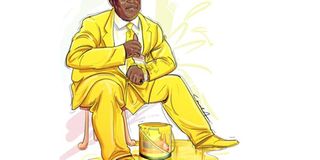Prime
Yellow Abiriga: Love for party or cover-up?

An illustration of Arua Municipality MP Ibrahim Abiriga painting himself with the NRM colour. ILLUSTRATION BY COSMAS ARINITWE
What you need to know:
- Shades of yellow. It is a daily sight at Parliament of ministers and unquestioning members of the ruling party spotting a dash of yellow a as a sign of party allegiance.
- However, for Arua Municipality MP Ibrahim Abiriga, it is not just a dash of yellow. It is the undershirt, the shirt, the necktie, the jacket, the trousers, the shoes and his recent addition; a yellow Volkswagen Beetle automobile, Isaac Imaka writes.
The word parliament comes from a French word, Parler— to speak; with your mouth. Members of Parliament are, therefore, supposed to talk.
One year later, Arua Municipality MP Ibrahim Abiriga is yet to say a single word in the House, verbally, but he has devised another way of speaking—dressing in his party colour every single day of the week.
“Ha! One day I came without a yellow colour on me and my spirit was very low. I felt I was missing something. I had to ask my driver to drive me back home and I change clothes,” Abiriga says.
“Everything on me has to at least have yellow if it is not fully yellow. The plate I use, the cups and my bed is yellow everything.”
With citizens increasingly becoming politically active and multiparty politics gradually getting entrenched in the body politic, political colours and imagery carry meanings with which people align themselves—sometimes repulsing others.
For instance, it is now an unpronounced policy for all files carrying government documents to Parliament to be yellow, the NRM party colour. It is the same with FDC.
It is also a daily sight at Parliament of ministers and unquestioning members of the ruling party spotting a dash of yellow as a sign of party allegiance.
However for Abiriga, it’s not just a dash of yellow. It is the undershirt, the shirt, the necktie, the jacket, the trousers, the shoes and his recent addition; a yellow Volkswagen Beetle automobile.
“I first saw politicians wearing their party colours long ago when I was in Primary Three. UPC leaders always wore their red and blue on weekends and so did their Democratic Party counterparts,” he says.
“When I left the army and joined politics I said I will always wear my party colours as a way of promoting it, but most importantly to send a message: that NRM is in leadership and it means good. Politicians should be proud of their political belonging and never fear to express their belonging.”

Left: Mr Abiriga besides his Beetle. Right: Abiriga (C) in his yellow attire. COURTESY PHOTO
Kilak North MP Anthony Akol, who bumped into the People&Power interview with Mr Abiriga, thinks the man is simply in psychological jail. He was a little disrespectful too.
“This man does not even deserve your attention. I have told him time and again to stop wearing those shirts but he has been psychologically imprisoned,” he said as he pointed a finger at him. “It is OK for someone to wear their party colours but not on a daily basis and not to fully be covered in yellow. This man needs help.”
Kampala fashion designer Anita Beryl says colours, especially in politics, are important in communicating one’s stand, especially when it is a big gathering.
“If it is an NRM event, they will know that you are part of them. If you come wearing blue then you will be sending a message,” she said. “In political engagements people who do not want to be attached to any party will not go wearing any political party colours.”
She, however, argues that fashion-wise, it is foolhardy to be fully tucked in yellow seven days a week like Abiriga.
“That is not fashion but a different thing all together. The reason you are wearing the colours is most important. If it was for fashion then one would think about the time and occasion they are going to attend, unless that MP is wearing a uniform,” she said.
Abiriga is, however, proud of his dress code and believes the President, his chairperson, and the Prime Minister are proud of him.
“When NTV run a story about my dressing, the President called me and personally thanked me. He said I should continue and that he has my back,” he said, adding that the Prime Minister also appreciates what he does.
“Some MPs are now jealous of me. They think I am being seen and appreciated more than them. Some even think I want to be a minister. I just love my party.”
According to Dr Frederick Kisekka-Ntale that is where the problem is.
“Colours give communications but sometimes the overzealous ones (MPs) do it to achieve more patrimony from the various structure of the party because they are seen to demonstrate loyalty,” said the politics and public affairs researcher.
As if to fit in the fact that Mr Abiriga is yet to say a word in Parliament, Dr Kisekka-Ntale says above and beyond loyalty, wearing political colours comes with some symbolic gifts.
“Colours help cover up for some individual inefficiencies. This may be a legislator who may not be very vocal and articulate in terms of advocacy. The colours help cover that gap especially the ability to legislate which is supposed to be his or her key output,” he said.
Mr Abiriga was voted to come to Parliament and talk. Parler. In Dr Kisekka-Ntale’s world, however, the former RDC’s wardrobe choice is not out of sheer love for the party he is supposed to speak for.
“It is parasitic technique to get away with incompetence since one would be seen to be loyal. It is one way to catch the eye of the chief whip, secretary general or party chairman.”




